1 YONGKOM YONGKOM (YONGOM, YONGGOM) ... 2,000 in Irian ...
1 YONGKOM YONGKOM (YONGOM, YONGGOM) ... 2,000 in Irian ...
1 YONGKOM YONGKOM (YONGOM, YONGGOM) ... 2,000 in Irian ...
Create successful ePaper yourself
Turn your PDF publications into a flip-book with our unique Google optimized e-Paper software.
has not yet been described, nor has the number of the dialects<br />
already been fixed. The population has been concentrated <strong>in</strong><br />
villages only for a short time; the local differences <strong>in</strong> speech<br />
are <strong>in</strong>numerable. Drabbe has been able to ascerta<strong>in</strong> two dialects<br />
viz. the dialects of Ni<strong>in</strong>ati, a village on the Muju, and of<br />
Metomka, situated to the south of the village of Kiptem. The<br />
names Ghawisi and Qa u ti are related to the word kati, which<br />
accord<strong>in</strong>g to Drabbe <strong>in</strong> the dialect of Ni<strong>in</strong>ati means "real man";<br />
therefore Drabbe speaks of this language as the Kati-language.<br />
We analyse the Ni<strong>in</strong>ati-dialect.<br />
- Boelaars 1950:77.<br />
*<br />
NORTHERN KATI (Northern Muju) is spoken on the upper Moejoe<br />
River <strong>in</strong> <strong>Irian</strong> Barat by perhaps 8,<strong>000</strong> people. Dr. Drabbé has<br />
published a detailed study of the N<strong>in</strong>atie dialect of Northern<br />
Kati ... Austen collected a list of 1100 words at the village of<br />
Kandam near the Ok Birim. Dr. Schoorl has published a glossary<br />
of 160 anthropological terms from the village of Kawangtet.<br />
Schoorl suggests that a separate dialect of Northern Kati is<br />
spoken <strong>in</strong> Kanggewot, and another <strong>in</strong> the village of Toemoetoe.<br />
This latter dialect is known as Are by the N<strong>in</strong>ggirum to the east,<br />
...<br />
- A. Healey 1964:44.<br />
*<br />
Northern Kati (Drabbe's Ni<strong>in</strong>ati dialect of Kati) is spoken<br />
by about 8,<strong>000</strong> people liv<strong>in</strong>g on the upper Muyu River. There are<br />
several dialects but detailed <strong>in</strong>formation is not at hand. ...<br />
- Voorhoeve 1975b:382.<br />
+ 8<strong>000</strong> [speakers]<br />
Dialects: There are several dialects, but detailed<br />
<strong>in</strong>formation is not to hand.<br />
Villages: Yiptem, Kanggim, Kawangtet, Onokbitan, Yeteram,<br />
Ketetput, Metemko, N<strong>in</strong>ati, Kunam, Kimki, Yibi, Tembutkim,<br />
Konontetput, Anggutb<strong>in</strong>, Komera, Mokpit, Mangkubun, Tawanokpit,<br />
Tome, Warumgi, Tumutu, Wamko, Arimko, Kopko, Kwitbon, Marib<strong>in</strong>,<br />
Yabiman, Katumbon, Walikubun.<br />
Comments: The language area is only vaguely def<strong>in</strong>ed by Drabbe as<br />
'round N<strong>in</strong>ati, east and west of the Muyu River'. It borders on<br />
South Kati which is spoken 'along the Kao River and <strong>in</strong> all the<br />
villages south of Yiptem'.<br />
- Voorhoeve 1975f:26.<br />
*<br />
Kati, Northern: 8,<strong>000</strong> speakers reported <strong>in</strong> 1987, <strong>in</strong> the<br />
south coast area east and west of the Muyu River, <strong>Irian</strong> Jaya.<br />
Also called Northern Muju, Ni<strong>in</strong>ati, Kati-Ni<strong>in</strong>ati, N<strong>in</strong>atie, or<br />
North Muyu.<br />
9


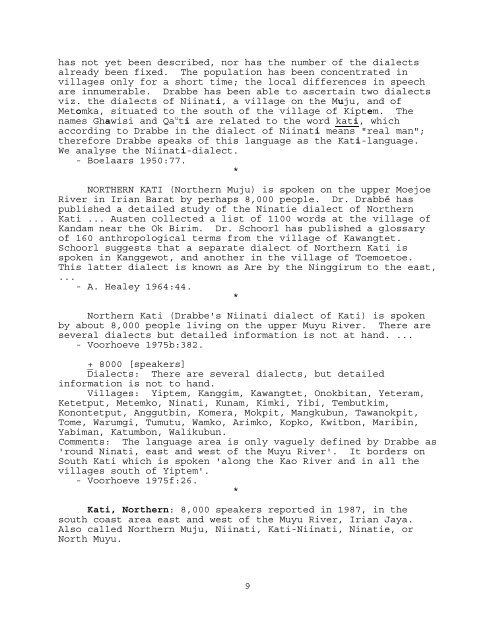
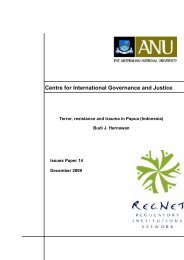
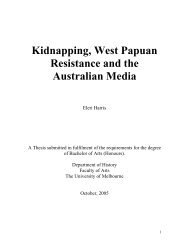
![[1958: Gahuku]. - PapuaWeb](https://img.yumpu.com/25139694/1/190x245/1958-gahuku-papuaweb.jpg?quality=85)
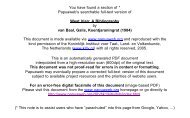


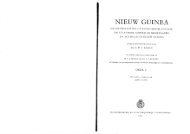
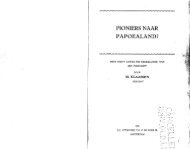
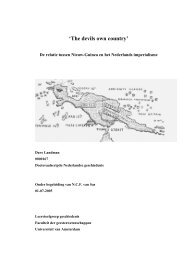
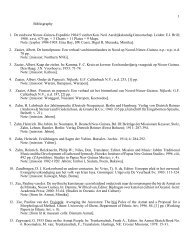
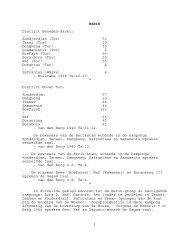

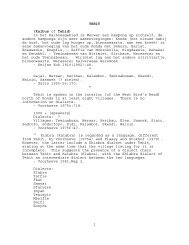
![1 EKARI (EKAGI) [Map] (cf S&C) Akaromani Apoejai ... - PapuaWeb](https://img.yumpu.com/19731685/1/190x245/1-ekari-ekagi-map-cf-sc-akaromani-apoejai-papuaweb.jpg?quality=85)
![WUTUNG [passim in text] Wutung (Oenaki, Oinåke) - Friederici ...](https://img.yumpu.com/15960045/1/190x245/wutung-passim-in-text-wutung-oenaki-oinake-friederici-.jpg?quality=85)